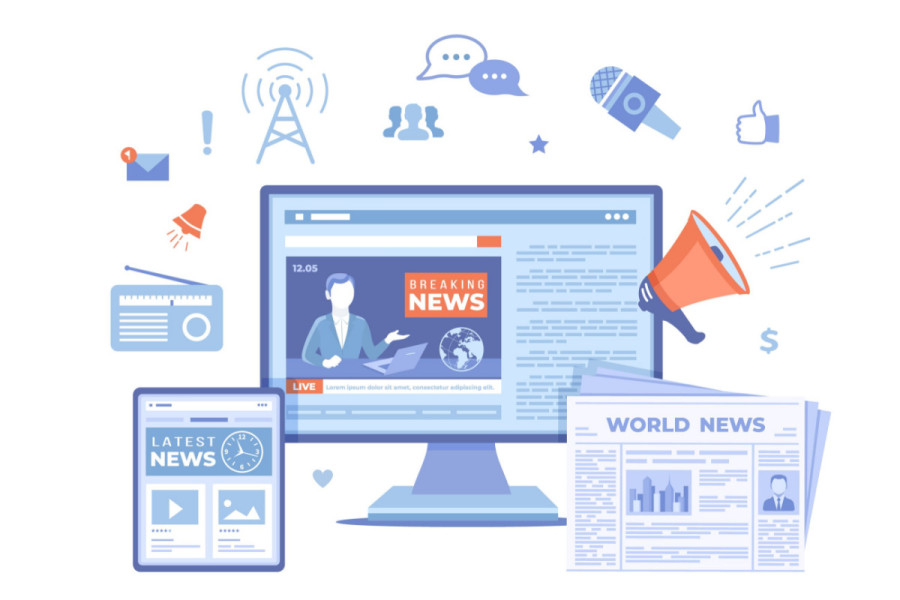Columns
The gods of mediated things
The media is often derided for all the ills, with little appraisal of the forces behind it.
Dharma Adhikari
My last column discussing content as king triggered some private conversations in my academic circle, prodding me to reflect on other salient aspects of mediated communicative practices.
Look also behind the content, urged one colleague.
Journalists or providers tend to play God, often consigning communicative ascendancy to content alone, commented another. If content is king, why the decline of the “authority” of content in recent decades?
Indeed, public criticism makes little discrimination between channels or their creations, lumping them into something called the media. It’s this media that is often derided for all the ills, with little appraisal of the forces behind it. The problem is that much of such criticism overlooks the providers or producers.
A colleague joked, “If content is king, who is the queen, prince or princess? There are others who pull the strings and constrain the power of the monarch in ways often not realised by the general populace.”
Content and channels, in themselves, are neutral, until we begin to trace the designs and motives of the providers behind them. Measures of credibility such as accuracy, fairness, impartiality, respect for people’s privacy, public interest and community wellbeing are matters of the mind or imbued human values rather than of materiality like technology or contents. Let’s not confuse the light with the mirror.
The digital divide has largely been rendered obsolete, but now digital segregation is intensifying the knowledge divide. In a democratic society, issues of trust and credibility hinge on public competence to scrutinise the gods of small and large mediated things in newspapers, TV and networked platforms.
Untangling providers
The word provider, pradayak in Nepali, refers to “one who gives”. We have all become givers in the digital age. Who actually gives or what is given doesn’t even sound important.
Not too long ago, journalists and media producers would sniff at the provider label. Now assortment is in fashion. Providers include users; and commenters have emerged as formidable players. Not infrequently, they are the ones that sway public opinion, much to the awe of headline writers.
Demystify the providers for a fair appraisal of media credibility. Simply blaming the messenger with little or no regard to context risks normalising our mediated state of affairs.
A media-literate public strives for a deeper understanding of the principles governing providers. We uphold a liberal media order riddled with authoritarian tendencies. Individual providers, particularly in the Wild West of new media or the internet, remain averse to or are limited in their capacity in internalising self-regulation.
Journalism informs, edifies as well as amuses. Columnists opinionate and librarians circulate resources. Advertisers, publicists or propagandists push for sales and influence. The question is how well they do their jobs, not what they do.
Owners as providers also invite much scrutiny of their roles. Ideally, information and media content may offer knowledge and truth, but it so happens that they are often organised to gain profit and power to the detriment of editorial independence. The extent of conflict of interest in institutional media is yet to be unearthed. How deep and wide do negative stereotypes of owners as maliks or overlords go? Do public attitudes towards start-uppers signal something different about the growing number of new, independent providers?
Knowledge of media codes or genres and their representational potencies comprises another evaluative means. Sometimes, it is the format of the information or media content that limits how detailed or accurate it can be. A developing story is often likely to be inaccurate in details and lacking in appropriate representation.
It is not unusual to see users citing the published word as sacred: “It is true, I saw it in the newspaper!” The media tends to be selective, referring to certain salient characteristics such as gender, race, ethnicity, political loyalty, sexuality or cultural trait. How many users look for the subtext? One encouraging sign is that users increasingly contest narrow, unfair, oversimplified, prejudicial or stereotypical images in our media.
Provider impact is part of the equation. Reporters run after scandals and YouTubers go to the extent of self-objectifying. Too often, people believe the media affects others and not themselves. The subtleties of the effects of edutainment, media-induced social withdrawal, violence or empathy are seldom discussed.
Calls for transparency
Commercial imperatives do provoke occasional outcries over dubious investments, exploitation of workers and poaching of talent. The media is criticised for running ads at the expense of objective information. Paid subscriptions are hard to come by, and ads serve as the life blood for providers. Public calls for transparency barely extend to advertorials, sponsored content, click bait, and more recently, media merchandise. Add to the list journalists or TV hosts appearing in ads and commercials.
Many people tend to dismiss providers as pretentious, unruly and without reins. However, the seeming chaos in the media exists within some order, based on formal standards and ethical codes, at least among committed and organised professionals. Unlike government regulations, ethics is about self-imposed standards.
Not least of all, oversight or monitoring mechanisms could help bolster the discovery process. Regrettably, public awareness and use of such existing mechanisms, notably the Press Council, independent watchdogs and trade publications, looks dismal. Most users would prefer to vent out their grievances directly on the platforms.
Hostility and vitriol offend more and enlighten less.
The work of watchdogs and monitors also leaves much to be desired. Public criticism of the media is thus burdened with multiple layers of appraisal needs.




 9.12°C Kathmandu
9.12°C Kathmandu













%20(1).jpg&w=300&height=200)

